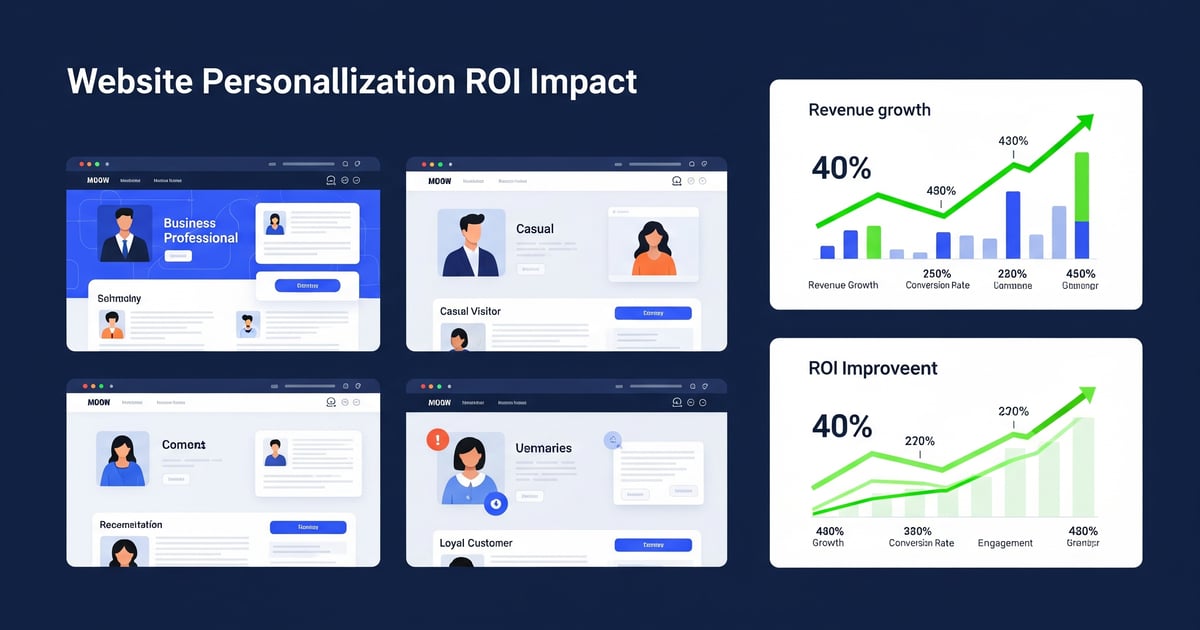How Website Personalization Drives 40% Higher ROI

In today’s competitive digital advertising landscape, the difference between a converting website and one that hemorrhages money often comes down to one critical factor: personalization.
Recent studies show that businesses implementing AI-powered website personalization see an average 40% increase in ROI compared to static, one-size-fits-all approaches. But what makes personalization so powerful, and how can you implement it effectively across all your website pages?
Table of Contents
Open Table of Contents
- The ROI Impact of Website Personalization
- Real-World ROI Results
- Why Personalization Works: The Psychology
- Implementation Strategy for Maximum ROI
- Measuring ROI Success
- Common Implementation Pitfalls
- The Future of Landing Page Personalization
- Getting Started: Your 30-Day ROI Plan
- Conclusion: The ROI of Relevance
The ROI Impact of Website Personalization
The Problem with Generic Website Content
Most businesses run multiple ad campaigns targeting different keywords, audiences, and pain points. Yet they often drive all this traffic to the same generic website content. This creates a massive disconnect across all page types:
- Search query: “project management for remote teams”
- Ad copy: “Perfect Remote Work Management”
- Landing page: “The Best Project Management Software”
This mismatch between user intent and page content is called message discontinuity, and it’s costing businesses millions in lost conversions.
The Personalization Solution
AI-powered personalization solves this by automatically adapting your landing page content to match each visitor’s specific search query and intent. Instead of showing everyone the same generic message, each visitor sees content that directly addresses their needs.
Example Transformation:
- Original headline: “The Best Project Management Software”
- Personalized for “remote team tools”: “Essential Remote Team Management Made Simple”
- Personalized for “agile methodology”: “Agile Project Management for Modern Teams”
Real-World ROI Results
Case Study 1: SaaS Company - 45% Conversion Increase
A B2B SaaS company running Google Ads for their project management tool implemented AI personalization across 15 landing pages:
Before Personalization:
- Average conversion rate: 2.3%
- Cost per acquisition: $145
- Monthly ad spend: $25,000
- Monthly conversions: 172
After Personalization:
- Average conversion rate: 3.3% (+45%)
- Cost per acquisition: $98 (-32%)
- Same monthly ad spend: $25,000
- Monthly conversions: 255 (+48%)
ROI Impact: The same ad spend generated 83 additional conversions monthly, representing $83,000 in additional monthly revenue.
Case Study 2: E-commerce - 62% Revenue Per Visitor Increase
An e-commerce company selling fitness equipment personalized their landing pages based on product-specific search queries:
Results after 3 months:
- Conversion rate improved from 1.8% to 2.9%
- Average order value increased by 18%
- Revenue per visitor increased by 62%
- Customer acquisition cost decreased by 35%
Why Personalization Works: The Psychology
1. Relevance Drives Action
When visitors see content that directly matches their search intent, they immediately recognize your solution as relevant to their specific problem. This creates an instant connection that generic content simply cannot achieve.
2. Reduced Cognitive Load
Personalized content eliminates the mental work visitors need to do to figure out if your solution fits their needs. The clearer the connection, the faster the decision.
3. Trust Through Understanding
When your landing page demonstrates understanding of their specific challenge, visitors perceive your brand as more knowledgeable and trustworthy.
Implementation Strategy for Maximum ROI
Phase 1: Identify High-Impact Pages (Week 1)
Start with landing pages that:
- Receive the most paid traffic
- Have the highest conversion potential
- Currently underperform benchmarks
Pro tip: Focus on pages with conversion rates below 3% - these typically see the biggest improvements.
Phase 2: Keyword Mapping (Week 2)
Create a comprehensive map of your target keywords and their corresponding visitor intents:
Keyword Category: "Remote Work Tools"
- Remote team collaboration
- Virtual team management
- Distributed team software
- Remote work productivity
Personalization Strategy:
- Emphasize collaboration features
- Highlight remote-specific benefits
- Use remote work imagery
- Include remote team testimonialsPhase 3: Content Variants (Week 3-4)
Develop personalized versions of key elements:
- Headlines: 3-5 variants per keyword group
- Value propositions: Benefit-focused messaging
- Social proof: Relevant customer stories
- CTAs: Action-oriented language
Phase 4: Implementation & Testing (Week 5+)
Deploy AI personalization technology that can:
- Detect visitor search queries automatically
- Match content variants to user intent
- A/B test different personalization strategies
- Provide detailed performance analytics
Measuring ROI Success
Primary Metrics
- Conversion rate improvement: Target 20-40% increase
- Cost per acquisition reduction: Aim for 25-35% decrease
- Revenue per visitor: Track overall value improvement
Secondary Metrics
- Bounce rate reduction: Indicates better relevance
- Time on page increase: Shows engagement improvement
- Quality Score improvement: Better ad performance
Advanced Attribution
Track the full customer journey to understand personalization’s impact on:
- Customer lifetime value
- Upsell/cross-sell opportunities
- Brand recall and repeat visits
Common Implementation Pitfalls
1. Over-Personalization
Don’t sacrifice brand consistency for personalization. Maintain your core value proposition while adapting supporting messages.
2. Insufficient Testing
Always validate personalization performance against control groups. Not every personalization attempt will succeed.
3. Technical Complexity
Choose solutions that integrate easily with your existing tech stack. Implementation shouldn’t require extensive development resources.
4. Ignoring Mobile Experience
Ensure personalized content works seamlessly across all devices, especially mobile where most traffic originates.
The Future of Landing Page Personalization
Emerging Trends
1. Multi-Modal Personalization Beyond text to include personalized images, videos, and layout changes based on user preferences.
2. Predictive Personalization AI that anticipates user needs based on broader behavioral patterns and industry trends.
3. Real-Time Optimization Systems that automatically optimize personalization strategies based on ongoing performance data.
Getting Started: Your 30-Day ROI Plan
Week 1: Audit & Baseline
- Analyze current landing page performance
- Identify top traffic sources and keywords
- Establish baseline conversion metrics
Week 2: Strategy Development
- Map keyword groups to user intents
- Create personalization content matrix
- Define success metrics and goals
Week 3: Implementation
- Set up personalization technology
- Create initial content variants
- Configure tracking and analytics
Week 4: Optimization
- Launch personalization campaigns
- Monitor performance metrics
- Make data-driven adjustments
Conclusion: The ROI of Relevance
Landing page personalization isn’t just a nice-to-have feature—it’s a competitive necessity. In an environment where customer acquisition costs continue to rise, the businesses that win are those that create more relevant, personalized experiences.
The 40% ROI improvement from personalization isn’t just a statistic—it’s the result of giving visitors exactly what they’re looking for, exactly when they need it. In a world of infinite choices, relevance is the ultimate differentiator.
Ready to see personalization transform your landing page ROI? The technology exists, the case studies prove its effectiveness, and your competitors are likely already implementing it. The question isn’t whether to personalize—it’s how quickly you can start.
Want to explore how AI-powered personalization could impact your specific business? Calculate your potential ROI improvement with our free personalization assessment.
